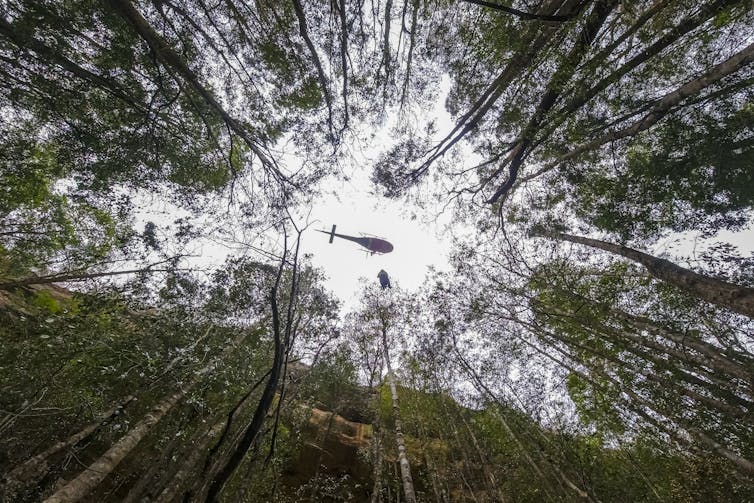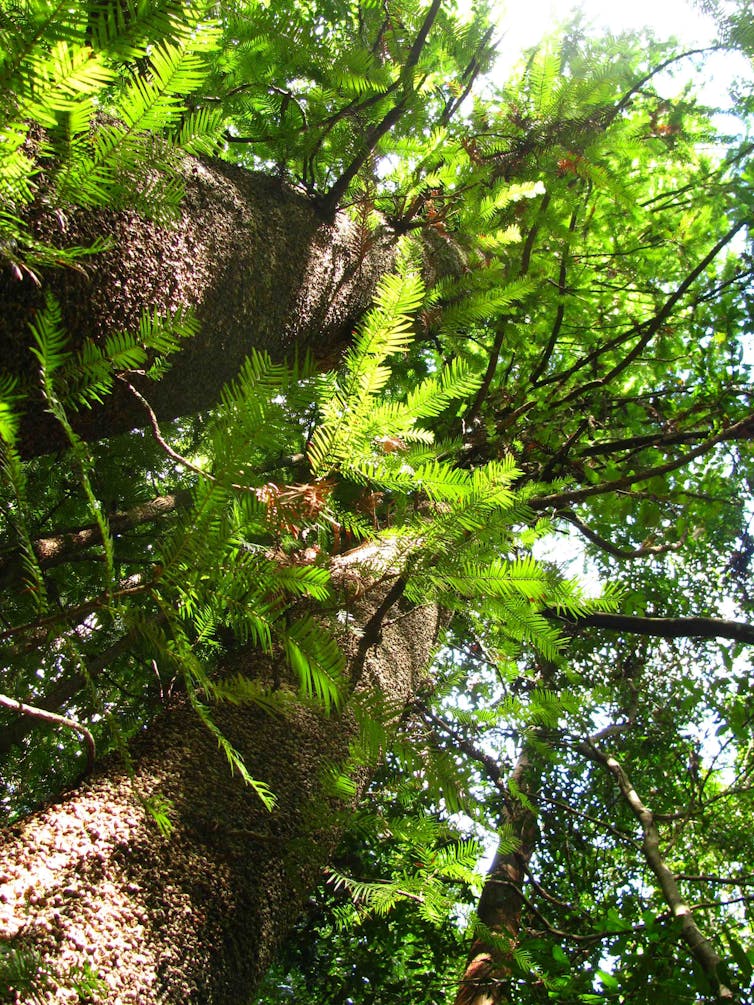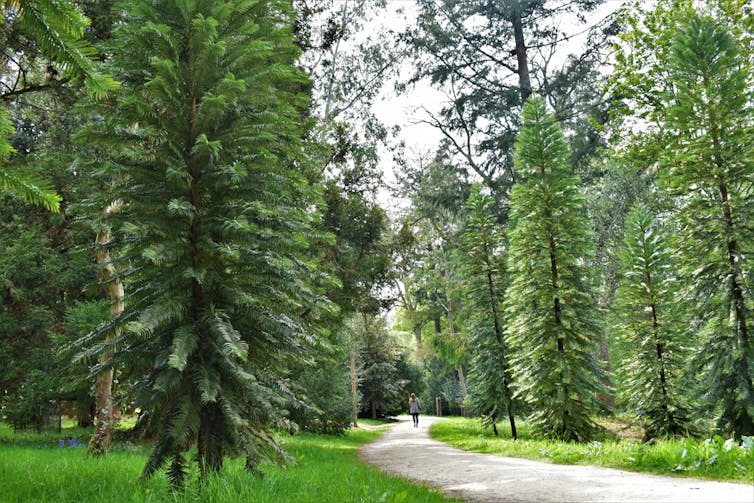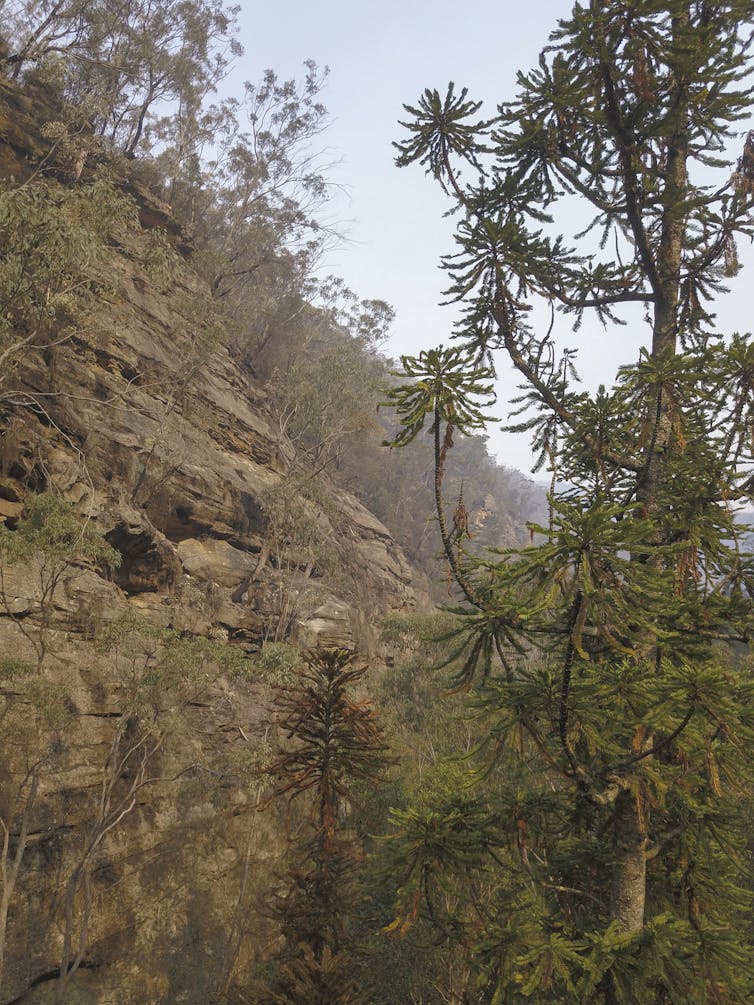Backyard gardeners around the world are helping to save Australia's deeply ancient Wollemi pine
- Written by Heidi Zimmer, Research associate, Southern Cross University
As bushfires blackened forests last summer, one tree species was protected by a specialist team of firefighters: the Wollemi pine.
These trees have a deeply ancient lineage dating back to when dinosaurs walked Gondwana 100 million years ago. Back then, rainforests – including Wollemi pines (or their cousins) – covered what became Australia.
So when a handful of Wollemi pines were discovered alive in 1994 on the brink of extinction, it caused a frenzy of interest that has barely died down among plant enthusiasts.
How firefighters saved the Wollemi pine from the bushfires.Today, fewer than 100 mature pines are left in the wild. But their exact location is one of the best kept secrets in Australian plant conservation, to protect them from pathogens such as the root-rotting phytophthora that might hitch a ride on human visitors.
But while rare in nature, our ongoing research with citizen scientists is finding Wollemi pines grow in backyards all over the world, in a range of environments, and this information can inform how we can protect them in the wild.
 An army of conservation experts helped save wild Wollemi pines from last summer’s bushfires.
AAP Image/Supplied by NPWS
An army of conservation experts helped save wild Wollemi pines from last summer’s bushfires.
AAP Image/Supplied by NPWS
From Gondwana to the garden
The Wollemi pine is considered the iconic poster-child for plant conservation. It’s an unusual-looking plant – each wild tree has many trunks covered in bark resembling bubbling chocolate and branches of lime or grey-green fern-like leaves. And in the wild, they grow to more than 40 metres tall.
The species is a member of the southern conifer family Araucariaceae, and its cousins include the monkey puzzle tree and the Norfolk Island pine. While considered a rainforest tree, many remaining in the wild exist between rainforest and dry eucalypt woodland, on the ledges of a sandstone gorge.
 Wollemi pines can stretch 40 metres in the wild.
Heidi Zimmer.
Wollemi pines can stretch 40 metres in the wild.
Heidi Zimmer.
Since the Wollemi pine was discovered 26 years ago, the protection effort has been intense, focusing on conservation in the wild.
One of the first strategies was cultivation. Horticultural scientists at the Australian Botanic Garden Mount Annan (Sydney) worked out how to propagate the species so it could be grown and enjoyed in gardens, reducing the risk of illegal visitation in the wild.
Read more: Wollemi pines are dinosaur trees
After the Australian Botanic Garden established a basic “insurance population” of plants propagated from the wild trees, some of the first cultivated Wollemi pines were distributed to botanic gardens in Australia and overseas, including in the UK’s Royal Botanic Gardens Kew.
In 2005, Wollemi pines were auctioned to the public at a Sothebys Auction. Since then, they’ve been exported to many nurseries around the world, and now grow in many public and private gardens.
I spy a Wollemi pine
When plants are very rare in the wild, or are very restricted in their distributions, conservation away from the site (ex situ) can play an important role in their survival.
This includes seed banking, translocation (establishing new populations of rare plants in new locations) and cultivation for the nursery trade.
Read more: Where the old things are: Australia's most ancient trees
Enter our I Spy A Wollemi Pine project. Fifteen years after the Wollemi pine became available for sale, our study asks people to report where Wollemi pines are growing in gardens across the world.
So far, results from the online survey have revealed the species grows across 27 different countries, from Australia to Russia, and the UK to Peru.
The tallest trees so far – stretching to 7 metres tall (though dwarfed by their wild counterparts) – have been reported from the UK. To date, 987 people have contributed data about Wollemi pines.
 Wollemi pines growing in Coates Wood, United Kingdom.
Ellen McHale © RBG Kew.
Wollemi pines growing in Coates Wood, United Kingdom.
Ellen McHale © RBG Kew.
What we can learn
Reading comments from survey participants – from “Has survived minus 10 degrees” to “I just love it” – has been a source of interest and joy for us researchers.
When the survey is finished, we’ll analyse the responses to understand what influences the growth of this species, such as different climates and soils.
Knowing how Wollemi pines grow in other parts of the world will provide gardening tips for home growers, but more importantly it will inform future conservation efforts in the wild in the face of climate change.
Read more: Bigfoot, the Kraken and night parrots: searching for the mythical or mysterious
For example, this research will provide information on what environments the Wollemi pine can tolerate. We’re discovering the hottest, coldest, wettest and driest places on earth this species can survive in.
This information can help us find places to establish new populations of Wollemi pines. It may also provide clues on the evolutionary history of this species and how it managed to survive multiple ice ages and other dramatic climate changes in deep history.
 Wild Wollemi pines grow in a secret, remote gorge in the Blue Mountains.
AAP Image/Supplied by NPWS
Wild Wollemi pines grow in a secret, remote gorge in the Blue Mountains.
AAP Image/Supplied by NPWS
Conservation with cultivation
Conserving Wollemi pines in backyards is not quite the same as Wollemi pines in the wild – in the same way its important to have pandas in the wild, and not just in zoos. But using cultivation for conservation does mean these species have much greater distribution today than they have ever had in the past.
In fact, this isn’t the first time a rare tree has ended up in gardens. The dawn redwood, thought to be extinct in the wild, was rediscovered in China in the 1940s and can now be found in gardens across the world.
And the internet is a great place to foster conservation. In online forums, people share every stage of their Wollemi babies’ growth, from seed germination to pine cone production.
Read more: Acts of arborial violence: tree vandals deprive us all
This love and connection to Wollemi pines might even help address “plant blindness”: the propensity for people to see, recognise and focus on animals rather than plants, despite plants being central to providing us with food, the air we breathe and our climate.
So, as more species are threatened with extinction every day, everyone’s actions – even in their own backyards or online – can make a difference.
If you have a Wollemi pine in your backyard, or know of a Wollemi pine in a park or garden, and would like to get involved in our citizen science survey, please click here.
Authors: Heidi Zimmer, Research associate, Southern Cross University



